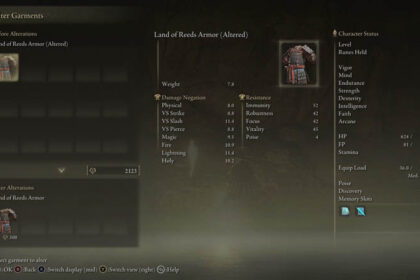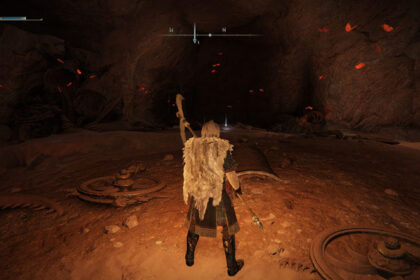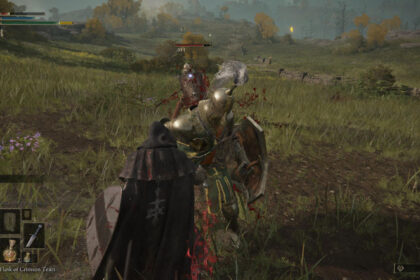FromSoftware has given mages more tools to utilize within Elden Ring. However, it is a massive investment to commit to a magic playstyle, and sorcerers tend to have their build together much later in the game.
Aside from leveling fundamental attributes like Vigor, you have to spread your stats between Intelligence and Mind in order to cast spells in the game. This is because different spells require different stat thresholds; the highest sorcery in the game demands 70 points in Intelligence.
Not to mention that other categories of spells require Faith and Arcane. Finally, don’t forget some points in Strength and Dexterity to properly wield your chosen weapon.
Collecting spells is also another issue for a new playthrough as a mage. While you can buy sorcery spells early in the game, most spells are acquired as rewards or loot spread throughout the Lands Between. As Elden Ring is a massive open-world experience, progress can sometimes feel slow and stunted.
Those fond of magic will naturally welcome the adventure, but for the undecided, they might want to know how good is sorcery in Elden Ring before committing. This article seeks to discuss both the advantages and disadvantages as well as the general feel of building sorcery in Elden Ring.
Sorcery Advantages and Disadvantages
Before answering how good is magic in Elden Ring, we first have to address the elephant in the room—does magic make Elden Ring easy?

The short answer is that yes, you’ll have an easier time using spells compared to melee builds. However, the more nuanced answer is that while you’ll generally have an easier time through the game’s content, it will take a while to get to that point. And, during situations where magic is lackluster, its ugly flaws will be standing front and center.
Elden Ring is a difficult game from start to finish, especially towards the end. Sorcery won’t trivialize the game nor secretly unlock easy mode, but there are many situations where sorceries create a more comfortable fight.
There are numerous clips online showing sorcerers effortlessly deleting a boss that perpetuate the easy mode stigma. Before you could even do that, you need to have the optimal conditions to blast away uncontested. Even so, other builds don’t have the same overwhelming power sorcery can dish out, even if under their best conditions.
That being said, this doesn’t mean I’m inviting an elitist mindset that diminishes a spell-based playstyle. Fun and a sense of fulfillment in Elden Ring are self-made, whether or not you choose to use all the intended tools in the game.
Just because another player used in-game features like summons and magic doesn’t invalidate a victory in your self-imposed challenge run. Like how Elden Ring offers a myriad of build customizations, it also offers many ways to overcome its obstacles.
“Getting Good” is a matter of mastering the game’s systems and applying it your way.
With all that aside, let’s discuss how magic works in Elden Ring, so we’ll have a shared understanding of its advantages and disadvantages.
First, it is essential to understand that sorceries scale from both the upgrades and bonuses of your catalyst and your points from Intelligence. Depending on the spell, it can also draw from either Faith or Arcane.
Most Glintstone Staves have a skill where it boosts specific schools of sorcery. For example, the Carian Glintstone Staff boosts Sword Sorceries like the Carian Piercer spell.
There are also other ways to buff a spell’s damage output, like talismans, armor, or magic enhancing spells.
You can dual-wield staves in Elden Ring. As long as you’re holding the staff in your off-hand, you’ll receive its passive bonuses.
Every sorcery in Elden Ring has a required number of attributes to cast. They also cost focus points (FP) to cast, and the Mind attribute increases that resource. Additionally, casting spells also drains some stamina.
Spells have to be memorized from any Site of Grace in the Lands Between; it is limited by your Memory Slots, which can be increased by finding Memory Stones. Usually, one spell takes up one memory slot, but other spells take even more.
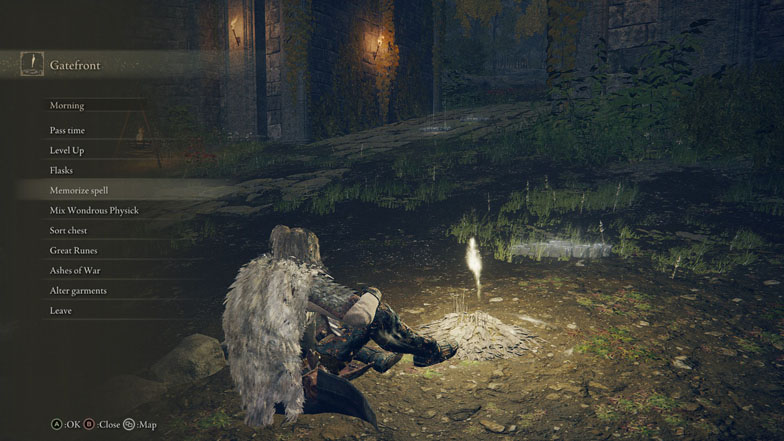
Dexterity pairs well with magic builds since that attribute hastens casting time. Although the legendary talisman Radagon Icon also shortens casting speed if you have the need to invest your points elsewhere.
There are over 70 sorceries in Elden Ring. Sorceries are either bought, received as a reward for defeating a boss, or by looting in various places in the Lands Between.
There are a few spells that can be converted from Remembrances gained from killing certain bosses. Unlike weapons, a player can’t drop a spell for another player to pick up.
Lastly, enemies have varying resistances, which can affect your total damage output. On some bosses, you’ll quickly deplete their health bar with a few spells because of their weak magic resistance. While against more resistant enemies, you need to have a contingency plan.
Elden Ring Sorcery Builds and Progression
The starting classes in the game are soft suggestions guiding you towards a specific archetype. During your playthrough, you’re free to allocate points wherever you wish.
You could even respec and reset your level to your base stats.
Those who want to focus on sorcery in Elden Ring will tend to gravitate towards the Astrologer or Prisoner class. These two are fantastic introductions to the game’s magic system.
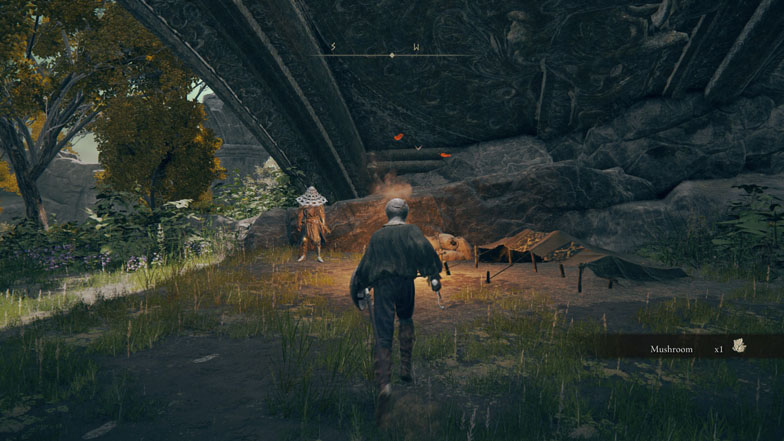
Both classes start with high Intelligence, Mind, and a staff to cast spells. The Prisoner has a few more points in Dexterity and Strength, while Astrologer is purely focused on spells.
Astrologer innately has the Glintstone Pebble and Glintstone Arc sorceries. These spells are more than enough to carry you through most of the game, and they even scale well. In fact, a little too well— more on that later.
Meanwhile, Prisoner has Magic Glintblade. While its applications aren’t as straightforward as the Astrologer’s staring spells, it is a very useful spell that will serve as your bread and butter for more evasive enemies.
For a while, your staring spells will be your only sorceries in Elden Ring. Gameplay can quickly go stale as you’re mostly keeping your distance, dodging, and spamming one spell.
But, finding Sorceress Sellen in Waypoint Ruins, Limgrave will introduce you to more sorceries. The gameplay won’t heavily diverge by then, but it’s nice to have a few new toys.
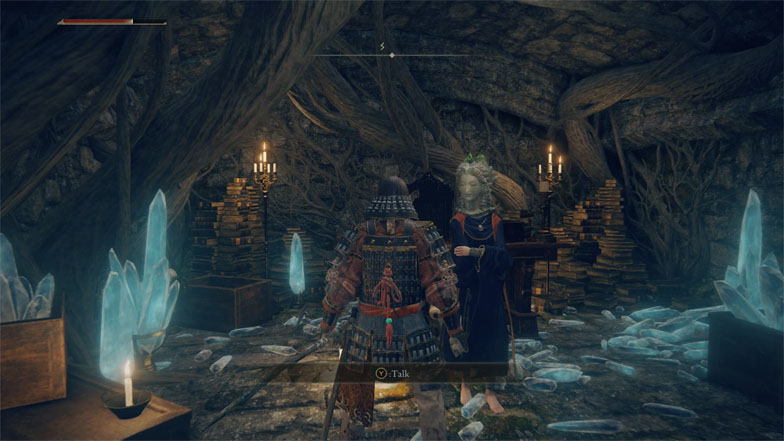
You’ll start to see some build variety if you can find the Royal House Scroll at a bandit camp on the south side of Limgrave. Giving the scroll to Sorceress Sellen lets her teach Glintblade Phalanx and Carian Slicer.
Carian Slicer is one of the best sorceries in Elden Ring. Using it conjures a magic sword and executes a sweeping slash that can be chained.
Its strongest feature is how quick the spell comes out, with almost no delay even after a roll. In addition, the damage output this spell out can put out is simply amazing.
There’s also another spell that sorcerers should gather early called Rock Sling. Found deep in the scarlet rot-blighted Caelid, this gravity-based spell deals serious physical damage and tends to stagger enemies after a few hits.
Additionally, the Meteorite Staff is also in the area. It immediately starts with an S scaling in Intelligence, but the downside is that it can never be upgraded.
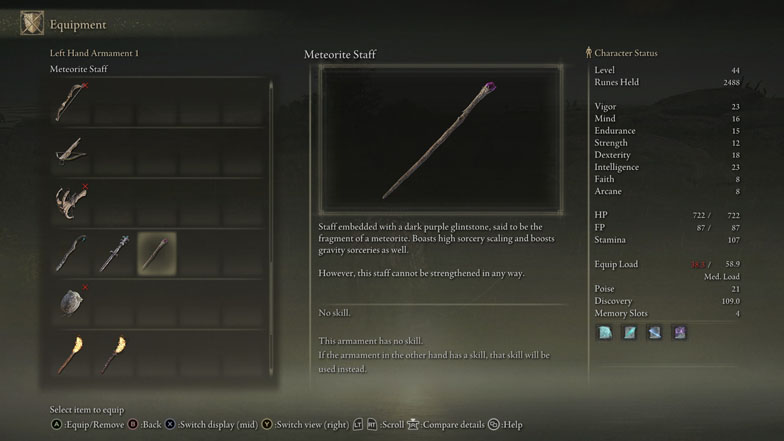
Nonetheless, it is a massive damage boost for sorceries without the slightest requirements. You’ll hold on to this staff for a long time before collecting enough upgrade materials to replace it with another one.
Glintstone Pebble, Glintstone Arc, Carian Slicer, and Rock Sling (plus Magic Glintblade if you started Prisoner) will serve as your main repertoire until you find better spells. At this point, the other available spells in Elden Ring won’t do as much damage as their inflated FP suggests.
It will take quite some time before you start finding worthwhile spells, but you’ll eventually find them. Especially as you explore Liurnia of the Lakes and progress through Raya Lucaria Academy and Lunar Princess Ranni’s quest.
A gripe you may have while playing with multiple spells is how outdated and clunky the UI feels. For Soulsborne veterans, this is something we’ve endured for all the previous installments.
Even so, pressing one button to cycle through all the spells causes confusion in the heat of a fight. You’ll want to put careful thought into the order of your spells and commit them to memory if you want to cast multiple spells during combat.
Regarding builds, sorcery heavily leans towards outputting damage without much utility. Hence, it isn’t as flexible when compared to the variety of spells Faith has in its collection.
The look and feel of each spell help create a thematic identity to curate your wizard. Staves also provide a functional advantage by boosting the damage output of schools of magic, like the previously mentioned Carian Staff upping Sword Sorceries.
You’ll pick what spells to bring during your magic playthrough in Elden Ring. While you’re still deciding what spells to sling, try these common magic builds:
The Glintstone Sorcerer is the Swiss Army knife of magic builds, cycling through a wide array of spells to deal with every situation. The main advantage of this mage is the ability to combine projectiles like Comet and Shard Spiral with slower spells like Stars of Ruins to fill the screen with magic.
As the Glintstone Sorcerer uses magic from various schools, it’s best to use a high-scaling staff like the Carian Regal Scepter. Lusat’s Glintstone Staff maximizes damage output if the additional FP cost can be managed.
A Battlemage or Spellblade primarily uses conjured weapons and Phalanx spells to dominate close-range encounters. These sorcerers favor spells like the Gavel of Haima and spells from the Carian school while using Phalanx spells to supplement their advances.
Battlemages also uses enchantment spells like Scholar’s Armament to buff their weapon. They fundamentally play like a melee class that cycles between multiple weapons in a fight. The Carian Glintstone Staff is a good staff for this playstyle.
Fire and Death Sorcerers level up both Intelligence and Faith. For all the flaws of Dark Souls 2, the Hexes build was undeniably fun, and this playstyle is the best replication of that.
With both attributes, these sorcerers can use Magma spells like Magma Shot and Death spells such as Rancorcall. The Gelmir Glintstone Staff and Prince of Death’s Staff boost Magma and Death spells, respectively. Fire and Death Sorcerers can naturally use the legendary Sword of Night and Flame with their stat distribution.
A personal favorite, Frost Mages use cold spells to apply the Frostbite status effect. These sorcerers use spells like Adula’s Moonblade and Glintstone Icecrag to freeze and shatter their opponents.

There are also many Ashes of War to assist in stacking Frostbite. For example, Hoarfrost Stomp and Ice Spear; the iconic Darkmoon Greatsword, also applies frost.
There aren’t any staves that directly boost Cold spells. But, Adula’s Moonblade is categorized as a Sword spell. Additionally, Carian Regal Scepter boosts Ranni’s Dark Moon.
Sorcerers have to be content with different flavors of dealing damage. As magic users tend to ignore resistances and elemental damage as their options are less dynamic than Faith-based casters.
Even though you have amassed your collection of spells, the gameplay is still mainly: keep distance, dodge, and release a projectile. Conjured weapons like Carian Greatsword help shake things up by encouraging playing within melee range.
The ability to become a glass cannon and output an insane amount of damage is the appeal and expectation of every aspiring sorcerer in Elden Ring. Though having different spells serve distinct functions is great for diversity and replayability.
Unfortunately, many of the spells in Elden Ring are upgraded versions of other spells. However, even that is debatable as some spells’ “weaker” versions outclass their stronger counterparts as they’re more efficient FP to damage ratio-wise.
FromSoftware has implemented magic with passion and care into Elden Ring. The animations, sounds, lore, and look for the various spells are top-notch. But, balancing issues like overtuning or undertuning some spells leave a sour taste for those who want to experiment with new sorcery builds.
Best Spells and Sorceries
To know how good is magic in Elden Ring, we’ll discuss a few of the best spells and sorceries. Additionally, we’ll also include some of the disappointments in the discussion.
First and foremost, there’s an issue with Glintstone Pebble—it’s too good for an early game spell. For the low cost of 7 FP, you have a reliable spell that never loses potency.
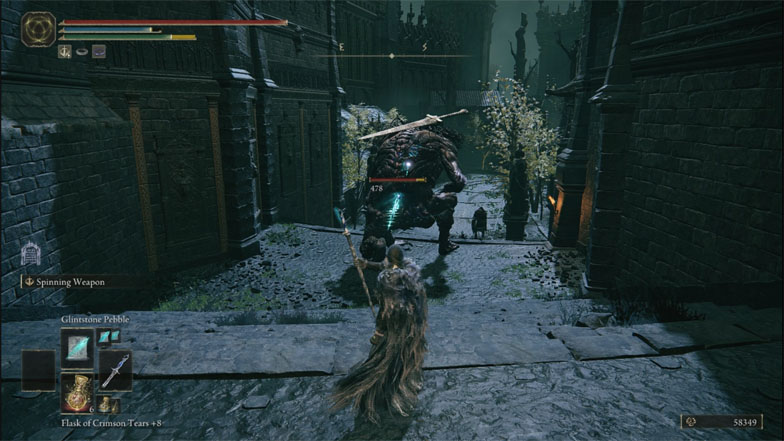
It has flaws like a limited range and slow tracking, but its damage to FP ratio makes up for it. You can spam this sorcery throughout the dungeon but still have more than enough to fight the boss.
It’s an efficient attack, optimal in almost every situation. But, unfortunately, Glintstone Pebble undermines the value of supposedly stronger sorceries as you can’t help but compare.
For example, I used the Glintstone Pebble, charged Glintstone Cometshard, and charged Comet against the troll near the Secluded Cell in Stormveil Castle. I removed all my talismans and used a +9 Carian Regal Scepter.
Under these conditions, Glintstone Pebble did 478 damage for the hit and 381 for the subsequent hits. It took seven hits to defeat the troll. A charged Glintstone Cometshard did 951 damage for the first hit and 791 for the following ones, taking four hits to deplete the troll’s health bar. Finally, a charged Comet did 1060 damage for the first hit and 884 for the rest, also taking four hits to vanquish the test subject.
It is clear that the stronger variants do more damage, especially when priming the attack. However, it is also important to see the FP costs.
With 26 points in Mind, I have 136 total FP. After defeating the troll, I still had 80 FP left in the tank using only Glintstone Pebble. Glintstone Cometshard left me with 60 FP, while I had 32 FP remaining with Comet.
In a scenario where you can blast away all your FP reserves like fighting inside an Evergoal, it’s better to use more powerful sorceries. After all, the quicker the boss goes down, the fewer chances it will have to hit you.
However, the damage to FP cost will start draining your resources during regular gameplay, like exploring dungeons. And factor in that the bosses in Elden Ring are more mobile and elusive means that you’ll lose that blue bar in just a few casts.
As you gather more Flasks and dump more points into Mind, you can start using steeper costing spells more comfortably. But until you get to that point, Glintstone Pebble will be your primary spell just because of how efficient it is.
Elden Ring has a problem balancing the scaling of spells. Most of the time, the damage output doesn’t match the drawbacks of the spell, such as higher FP cost, longer cast times, and longer vulnerability windows.
Following the same trend, Carian Slicer is also another mighty but cheap spell. Whenever you have a window to attack, you can chain multiple of these since it comes out so fast.
It even comes out with almost no delay time after a roll. Pair this spell with Lusat’s Staff and you’ll be amazed at how fast you can melt enemies.
In general, most of the conjured weapons have varying degrees of usefulness. Loretta’s Greatbow lets you shoot a massive arrow from a magic greatbow, but leaves you vulnerable for a long time. It’s best used to snipe enemies from a long range.

Adula’s Moonblade is a spell I frequently use during longer punishment windows. After creating a long frost blade, you’ll perform a sweeping slash plus a projectile that stacks Frost. It is risky and takes a lot of FP, but the damage is worth it.
For multiple reasons, it’s always handy to have Rock Sling in your spell list. It does a lot of physical damage to counteract magic-resistant enemies, has a delayed cast to trick the enemy AI, and deals a metric ton of poise damage. It is so satisfying to launch all three boulders to the colossal snout of a dragon.
Sadly, the other gravity spells aren’t worth using. I really wanted to like Meteorite of Astel, but it’s one of sorceries biggest disappointments.
Meteorite of Astel is a gravity-based spell where you summon a hail of meteorites to rain down on an area in front of you. On paper, it’s flashy and deals tremendous damage with a high stagger chance, but good luck hitting anything with its atrocious attack pattern.
With proper positioning, it’s satisfying to rain rocks down against giant bosses like dragons. But you have put in a lot of extra effort to get this unreliable spell to work.
While we’re on the subject of poise breaking, Greatblade Phalanx is a consistent tool for the job. This spell doesn’t have amazing damage, but its fast cast time and projectile mean that you’ll often put enemies on their knees.
A quick tip: don’t move up for the riposte of staggered enemies as a sorcerer. Instead, use the few precious seconds to prime up your most damaging spell.
Gavel of Haima and Cannon of Haima are sorceries that highlight the destructive force of spells in the game. They have a great balance of damage and drawbacks and more spells should be tuned in that manner.
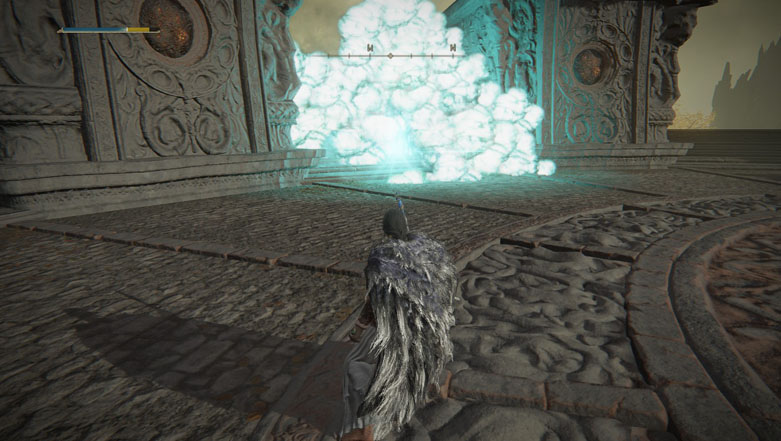
Night Maiden’s Mist is one of the most underrated sorceries in Elden Ring. Using it releases a life-sapping mist, which can be charged to increase the radius further.
This spell does a surprisingly good amount of damage. Furthermore, it is convenient against shielded enemies like Crucible Knight as they’ll continue to receive damage so long as they’re inside the mist. Throw this down on a slow target, and the fight is pretty much over.
For PvP, Rancorcall and Ancient Death Rancorcall are great options to apply pressure. The multiple slow-moving projectiles combined with accurate tracking will cause your opponents to run and panic. Just don’t use it in PvE since the damage scaling is pathetic.
If you love PvP, Swift Glintstone Shard is your most reliable way to deal damage against other tarnished. It’s fast and deals high damage for its meager FP cost.
I’m happy to say the most legendary spells and late-game sorceries that require high intelligence are worth the investment.
Ranni’s Dark Moon is the ideal sorcery to start a fight. Incarnate a dark moon and launch it at the enemy; it deals reasonable damage, stacks frostbite, and most importantly, reduces magic negation.
If you manage to hit this spell at the beginning, you’re guaranteed a smoother fight. So follow Lunar Princess Ranni’s quest to find it.
Stars of Ruins fires twelve speedy shooting stars. It deals a lot of damage and can even be charged to boost it further. What’s best about this legendary spell is how easy it is to use, as you can stay mobile while casting it. In fact, it’s very effective in PvP because of its excellent tracking.

Finally, there are certain situations where Comet Azur is all you’ll need for a boss battle—nothing comes close to the raw power that this spell can output. Of course, it has drawbacks like horrendous tracking and a huge FP drain, but when the conditions are right, you don’t have to do anything else but blast this spell.
When you find Comet Azur in Mt. Gelmir, you can start Sorceress Sellen’s quest back in Limgrave. Follow the quest to receive spells and armor fit for any sorcery build in Elden Ring.
There are many fun sorceries in Elden Ring, and we only touched some of the best and worst spells in the game. Make sure to experiment with each and every spell to see which ones better suit your playstyle.
Magic Against Elden Ring Bosses
As boss battles are the game’s highlight, it is essential to know how these spells fare up against them to know how good sorcery is in Elden Ring.
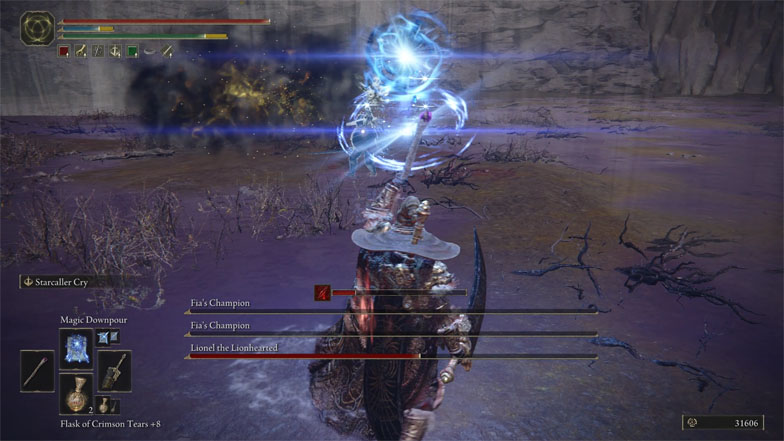
Against bosses with a sorcery build, you’re either having the easiest time of your life or the worst. Unfortunately, it isn’t often that you’ll fight a boss that will give you the right amount of challenge.
Slow and immobile bosses are a cakewalk for sorcerers, like the Stonedigger Troll and Erdtree Avatar. You’ll be actively pelting them with sorceries left and right without much of a threat.
Frequently, there isn’t much strategy here, and simple spell spam will do the trick. Due to their sluggish nature, you don’t even need to dodge when you can just sprint away to create more distance between you and the boss.
Occasionally, some slow bosses have a ranged attack you have to dodge. Evading their attack is the most interactivity you’ll get from the encounter; a momentary inconvenience from spamming your ranged spells.
Sorcerers also have a distinct advantage against large bosses, like dragons. Melee combatants have to go up close and personal against these bosses, often chipping away at their lower area.
The camera is often your worst enemy during this time, as your proximity to their massive size often obscures their next attack. Everyone knows the pain of fighting an Ulcerated Tree Spirit in a cramped area.
It’s best to fight with an unlocked camera during these circumstances. Keeping it locked on the bosses will disorient you when the camera erratically snaps to their movement.
Sorcerers don’t have that problem as the distance allows them to see the whole picture. Additionally, they can lock on the vulnerable parts of the enemy to deal critical damage.
As sorcerers prefer to fight from further away, it lets them avoid some boss mechanics while simultaneously returning their own fire. Meanwhile, melee players have to either wait for a safe window or risk their health.
For example, Magma Wyrm has an attack where it runs and covers the arena in pools of lava. Sorcerers can safely reposition while also fighting back during this time.
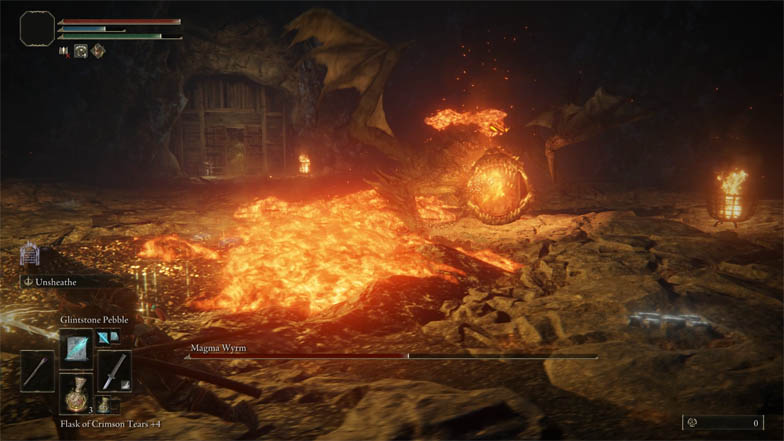
Sorcerers can also take advantage of the slow start of the fight. When bosses have a prolonged state or a roar when triggering the fight, it’s basically an invitation to deplete their health bar with strong spells.
For example, you can quickly burst down the Guardian Golem in Highroar Cave because of its slow wake-up animation. Even a simple roar is enough to defeat them without a fight.

Gang fights are also somewhat comfortable for sorcerers in Elden Ring. Though you have to sprint around the arena more often, at least you won’t be overwhelmed attempting to dodge multiple attacks.
There are many situations where your range and power can overwhelm the boss. Most of the time, playing as a magic build in Elden Ring is about depleting their health bar fast enough, so you don’t need to learn their attack patterns.
On the other side of the coin, it feels miserable playing against fast bosses with numerous gap closers. I was generally cruising through the early game until Runebear in Weeping Peninsula forced me to use summons for the first time.
Bosses like the Red Wolf of Radagon in Raya Lucaria Academy can overwhelm a sorcerer. There isn’t enough time to prime your bread and butter spells, and even if you could get it off, their speed means they can outrun, dodge, and duck through most of your offenses.
Swift spells like Carian Slicer will serve as your primary damaging tool. The Phalanx school of spells will also reliably hit the bosses when they attempt to close the gap.
Although hectic, those fights are still manageable and fun with some patience.
The worst offenders against magic builds are fast bosses with hard input reading. Because of input reading, bosses tend to lunge as soon as you heal or dodge as soon as you cast a spell.
It is a frustrating experience playing as a sorcerer when a boss does nothing when you’re idle but quickly pounces on you the second you fire a spell. NPC invaders and bosses like Alecto, Black Knife Ringleader, will strafe circles around your spells—often chaining multiple dodges in a row.
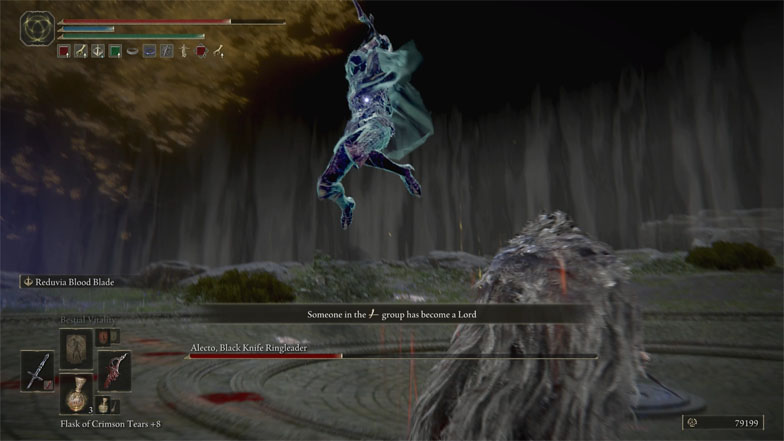
However, their AI is exploitable, and sometimes it feels like cheesing a boss instead of having a fair fight.
Since enemies tend to dodge on cast, you can hit them for free using a delayed spell like Rock Sling. Bosses can’t also dodge set-up spells like Magic Glintblade and Phalanx spells.
For some reason, Night Comet and Ambush Shard tend to break the bosses AI. Both are Night sorceries that fire semi-invisible magic comets. Bosses don’t dodge these spells and will happily accept all these projectiles flung at their faces.
As you progress late into the game, bosses will become even faster. As a sorcerer, you’ll start to narrow down your spells for fighting as you’re forced to choose the most practical ones to fight these bosses.
In conclusion, sorceries are very good in Elden Ring if we’re talking about raw damage potential. But, the lack of utility and poor scaling on supposedly more powerful spells doesn’t encourage diversifying your build.
There are a lot of flashy and unique spells that players desperately want to incorporate into their build. Hopefully, FromSoftware will take a closer look at these issues to fix magic in Elden Ring. Fortunately, there are many strong intelligence-based weapons and Ashes of War to retain a player’s interest.


